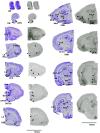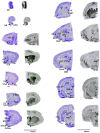Characterization of oxytocin and vasopressin receptors in the Southern giant pouched rat and comparison to other rodents
- PMID: 38803478
- PMCID: PMC11128605
- DOI: 10.3389/fendo.2024.1390203
Characterization of oxytocin and vasopressin receptors in the Southern giant pouched rat and comparison to other rodents
Abstract
Vasopressin and oxytocin are well known and evolutionarily ancient modulators of social behavior. The distribution and relative densities of vasopressin and oxytocin receptors are known to modulate the sensitivity to these signaling molecules. Comparative work is needed to determine which neural networks have been conserved and modified over evolutionary time, and which social behaviors are commonly modulated by nonapeptide signaling. To this end, we used receptor autoradiography to determine the distribution of vasopressin 1a and oxytocin receptors in the Southern giant pouched rat (Cricetomys ansorgei) brain, and to assess the relative densities of these receptors in specific brain regions. We then compared the relative receptor pattern to 23 other species of rodents using a multivariate ANOVA. Pouched rat receptor patterns were strikingly similar to hamsters and voles overall, despite the variation in social organization among species. Uniquely, the pouched rat had dense vasopressin 1a receptor binding in the caudate-putamen (i.e., striatum), an area that might impact affiliative behavior in this species. In contrast, the pouched rat had relatively little oxytocin receptor binding in much of the anterior forebrain. Notably, however, oxytocin receptor binding demonstrated extremely dense binding in the bed nucleus of the stria terminalis, which is associated with the modulation of several social behaviors and a central hub of the social decision-making network. Examination of the nonapeptide system has the potential to reveal insights into species-specific behaviors and general themes in the modulation of social behavior.
Keywords: autoradiography; nonapeptide; social behavior; social organization; striatum.
Copyright © 2024 Freeman, Arenas, Lee, Singh and Ophir.
Conflict of interest statement
The authors declare that the research was conducted in the absence of any commercial or financial relationships that could be construed as a potential conflict of interest.
Figures






Similar articles
-
Comparison of the distribution of oxytocin and vasopressin 1a receptors in rodents reveals conserved and derived patterns of nonapeptide evolution.J Neuroendocrinol. 2020 Apr;32(4):e12828. doi: 10.1111/jne.12828. Epub 2020 Feb 11. J Neuroendocrinol. 2020. PMID: 31925983
-
Distribution of vasopressin 1a and oxytocin receptor protein and mRNA in the basal forebrain and midbrain of the spiny mouse (Acomys cahirinus).Brain Struct Funct. 2023 Mar;228(2):413-431. doi: 10.1007/s00429-022-02581-z. Epub 2022 Oct 21. Brain Struct Funct. 2023. PMID: 36271259 Free PMC article.
-
Oxytocin and vasopressin receptor distributions in a solitary and a social species of tuco-tuco (Ctenomys haigi and Ctenomys sociabilis).J Comp Neurol. 2008 Apr 20;507(6):1847-59. doi: 10.1002/cne.21638. J Comp Neurol. 2008. PMID: 18271022
-
Comparing vasopressin and oxytocin fiber and receptor density patterns in the social behavior neural network: Implications for cross-system signaling.Front Neuroendocrinol. 2019 Apr;53:100737. doi: 10.1016/j.yfrne.2019.02.001. Epub 2019 Feb 10. Front Neuroendocrinol. 2019. PMID: 30753840 Free PMC article. Review.
-
Oxytocin, vasopressin, and social recognition in mammals.Peptides. 2004 Sep;25(9):1565-74. doi: 10.1016/j.peptides.2004.05.019. Peptides. 2004. PMID: 15374658 Review.
References
Publication types
MeSH terms
Substances
LinkOut - more resources
Full Text Sources

